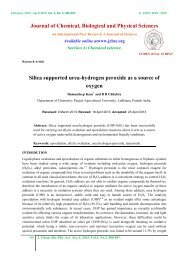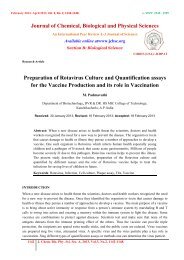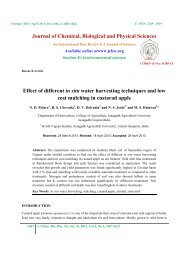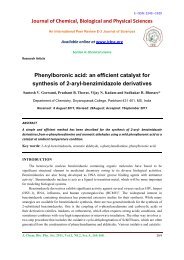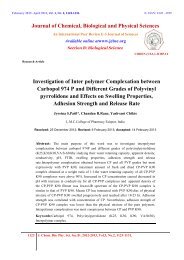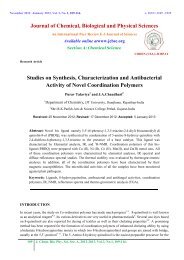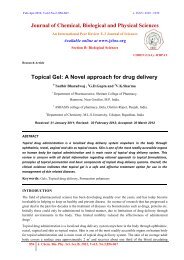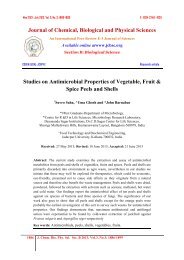A Comparative Study of Antimicrobial and DNA Clevage Activity of ...
A Comparative Study of Antimicrobial and DNA Clevage Activity of ...
A Comparative Study of Antimicrobial and DNA Clevage Activity of ...
Create successful ePaper yourself
Turn your PDF publications into a flip-book with our unique Google optimized e-Paper software.
August 2013 - October 2013, Vol. 3, No. 4; 2482-2491. E- ISSN: 2249 –1929Journal <strong>of</strong> Chemical, Biological <strong>and</strong> Physical SciencesAn International Peer Review E-3 Journal <strong>of</strong> SciencesAvailable online atwww.jcbsc.orgSection A: Chemical ScienceCODEN (USA): JCBPATResearch articleA <strong>Comparative</strong> <strong>Study</strong> <strong>of</strong> <strong>Antimicrobial</strong> <strong>and</strong><strong>DNA</strong> <strong>Clevage</strong> <strong>Activity</strong> <strong>of</strong> Metal(II)Complexes <strong>of</strong> Coumarin DerivativesDisha Tilala 1* , Manish Solanki 2 , Denish Karia 31 Kadi Sarva Vishwavidyalaya, G<strong>and</strong>hinagar, (Gujarat) India.2 Department <strong>of</strong> Chemistry, Gujarat Collage, Ahmedabad-382330 (Gujarat) India.3 Department <strong>of</strong> Chemistry, A. C. Science College, Borsad-388540 (Gujarat) India.Received: 20 August 2013; Revised: 6 September 2013; Accepted: 15 September 2013Abstract: New transition metal complexes <strong>of</strong> the composition, M[L(H 2 O)] 2 , whereM= Fe(II), Ni(II), Co(II) <strong>and</strong> Cu(II); L= lig<strong>and</strong>s prepared from 3-acetyl-4-hydroxy-8-methylpyrano[3,2-c]chromene-2,5-dione(L I ) <strong>and</strong> 4-hydroxy-8-methyl-3-(3-oxobutyanoyl)pyrano [3,2-c]chromen-2,5-dione (L II ), were synthesized <strong>and</strong> characterized byelemental analyser, conductivity measurement, IR, UV-Vis. <strong>and</strong> 1H-NMR spectraltechniques. The low conductance data provide evidence for the non-ionic nature <strong>of</strong> thecomplexes. The antimicrobial activities <strong>of</strong> the lig<strong>and</strong>s <strong>and</strong> their complexes have beenstudied by screening the compounds against the bacteria E. coli <strong>and</strong> B. megaterium <strong>and</strong>also the fungi C. albicans <strong>and</strong> A. niger. The data indicate that most <strong>of</strong> the metalcomplexes have higher antimicrobial activity than the free lig<strong>and</strong>s. The <strong>DNA</strong> cleavageexperiments, performed using gel electrophoresis with the corresponding metalcomplexes in the presence <strong>of</strong> H 2 O 2 showed good results.Keywords: transition metal complexes, antimicrobial, <strong>DNA</strong> cleavage, gelelectrophoresis2482 J. Chem. Bio. Phy. Sci. Sec. A; Aug. 2013-Oct.2013; Vol.3, No.4; 2482-2491.
A <strong>Comparative</strong>....DishaTilala et.al.INTRODUCTIONTransition metal complexes with an ability to cleave <strong>and</strong> bind <strong>DNA</strong> under physiological conditionsare <strong>of</strong> current interests for their varied applications in nucleic acid chemistry, viz., as sequencespecified <strong>DNA</strong> cleaving agents, foot printing agents <strong>and</strong> diagnostic tools in medical field 1-9 . Metalcomplexes with tunable coordination environments <strong>and</strong> versatile physicochemical properties <strong>of</strong>ferscope for designing highly sensitive diagnostic agents for medical applications as exemplified by thechemotherapeutic agents like cis-platin <strong>and</strong> bleomycins 10-12 . <strong>DNA</strong> cleavage could be achived viaoxidative or hydrolytic pathways 13-15 . Hydrolytic <strong>DNA</strong> cleavage involves cleavage <strong>of</strong> phosphodiesterbond to generate fragments which can be subsequenty relegated.Hydrolytic cleavage active species mimic restriction enzymes. Oxidative <strong>DNA</strong> cleavage involveseither oxidation <strong>of</strong> the deoxyribose moiety by abstraction <strong>of</strong> sugar hydrogen or oxidation <strong>of</strong>nucleobases 16 . Oxidative cleavage <strong>of</strong> <strong>DNA</strong> occurs in the presence <strong>of</strong> additives or photoinduced <strong>DNA</strong>cleavage agents 17,18 . Photocleavers require the presence <strong>of</strong> a photosensitizer that can be activated onirradiation with UV or visible light the redox active ‘chemical nucleases’ are effective cleavers <strong>of</strong><strong>DNA</strong> in the presence <strong>of</strong> a reducing agent or H 2 O 2 as an additive 6, 8 . Here in, we present the synthesis,characterization, antimicrobial <strong>and</strong> oxidative <strong>DNA</strong> cleavage activity <strong>of</strong> two novel lig<strong>and</strong>s 3-acetyl-4-hydroxy-8-methylpyrano[3,2-c]chromene-2,5-dione <strong>and</strong> 4-hydroxy-8-methyl-3-(3-oxobutyanoyl)pyrano[3,2-c]chromen-2, 5-dione <strong>and</strong> their metal complexes.EXPERIMENTALApparatus <strong>and</strong> reagents: All chemicals used were <strong>of</strong> analytical reagent (AR) grade <strong>and</strong> <strong>of</strong> thehighest purity available. They include phosphorous oxychloride (Spectrochem), Phenol, malonic acid,zinc chloride, sodium carbonate, hydrochloric acid, ethanol, ammonia, agarose (Merck), <strong>and</strong> nutrientbroth, glucose, yeast extract (Helini biomolecules). CT <strong>DNA</strong> was purchased from Genei chemicalcompany, India. Solutions <strong>of</strong> CT <strong>DNA</strong> in Tris–HCl/NaCl (pH 7.2) buffer medium gave a ratio <strong>of</strong>A 260 /A 280 , <strong>of</strong> ca. 1.8–1.9, indicating that the <strong>DNA</strong> was sufficiently free from protein contamination 19 .Stock solutions were kept at 4°C <strong>and</strong> used within 4 days. Doubly distilled water was used to preparethe buffer. All the melting points were determined in open glass capillaries in a liquid paraffin-bath<strong>and</strong> are uncorrected. The NMR Spectra were recorded on BRUKER NMR Spectrometer (300 MHz)<strong>and</strong> IR spectra on Shimadzu, 435-IR in frequency range <strong>of</strong> 4000-400 cm -1 using KBR pellet technique.The conductivity <strong>of</strong> metal complexes was determined using Systronic Conductivity Bridge. ElementalAnalyses were performed on a Perkin- Elmer 2400 CHN elemental Analyzer Model 1106.Synthesis <strong>of</strong> 4-hydroxy-7-methyl-2H-chromen-2-one (1): It was prepared by the reported methodgiven by shah & co-workers 20 . m-cresol (0.1mole) <strong>and</strong> malonic acid (0.1mole) were added to amixture <strong>of</strong> phosphorous oxychloride (40ml) <strong>and</strong> freshly fused zinc chloride (40g). The reactionmixture was heated on water bath at 60-70 o C for 8-10 hrs <strong>and</strong> poured into ice. The solid residue isfiltered out <strong>and</strong> treated with hot saturated sodium carbonate. The filtrate was slowly acidified withconcentrated hydrochloric acid. At the point <strong>of</strong> neutralization, the precipitates were obtained werefiltered <strong>and</strong> washed with water <strong>and</strong> further dried <strong>and</strong> recrystalised with methanol.Synthesis <strong>of</strong> 4-hydroxy-8-methylenepyrano[3,2-c]chromene-2,5-dione (2): 4-hydroxy-7-methyl-2H-chromene-2-one (0.1mole) <strong>and</strong> malonic acid (0.1mole) were added to a mixture <strong>of</strong> phosphorousoxychloride (40mL) <strong>and</strong> freshly fused zinc chloride (40g). The reaction mixture was heated on waterbath at 60-70 o C for 16-18hrs <strong>and</strong> poured into ice. The solid residue is filtered out <strong>and</strong> treated with hotsaturated sodium carbonate. The filtrate was slowly acidified with concentrated hydrochloric acid. At2483 J. Chem. Bio. Phy. Sci. Sec. A; Aug. 2013-Oct.2013; Vol.3, No.4; 2482-2491.
A <strong>Comparative</strong>....DishaTilala et.al.the point <strong>of</strong> neutralization, the precipitates are obtained are filtered <strong>and</strong> washed with water <strong>and</strong> furtherdried <strong>and</strong> recrystalised with methanol.Synthesis <strong>of</strong> 3-acetyl-4-hydroxy-8-methylpyrano [3, 2-c] chromene-2, 5-dione (L I ): Acetylderivatives are prepared 21-26 by acetylation <strong>of</strong> product-II in presence <strong>of</strong> acetic acid <strong>and</strong> phosphorousoxychloride. 4-hydroxy-8-methylenepyrano [3, 2-c] chromene-2, 5-dione (1g) was dissolved inmixture <strong>of</strong> glacial acetic acid (5.0 mL) <strong>and</strong> phosphorous oxychloride (4.0 mL). The reaction mixturewas gently refluxed for 4-5hrs., then poured into ice water. 3-acetyl-4-hydroxy-8-methyl-pyrano[3,2-c]chromene-2,5-dione is solid mass, crystallised form glacial acetic acid.Synthesis <strong>of</strong> 4-hydroxy-8-methyl-3-(3-oxobutanoyl)pyrano [3,2-c]chromene-2,5-dione (L II ):Acetyl derivatives (L I ), on its further reaction with ethyl acetate in presence <strong>of</strong> sodium gave acetoacetyl derivatives (L II ) 21-26 . 3-acetyl-4-hydroxy-8-methyl-pyrano [3, 2-c] chromene-2, 5-dione (1g)dissolved in ethyl acetate (25.0 mL) was added to pulverized sodium (1g) <strong>and</strong> refluxed for 8hrs. It wasthen decomposed with ice <strong>and</strong> extracted with ether. The aqueous layer on acidification gavesubstituted 4-hydroxy-3-(3-oxobutyanoyl) pyrano [3, 2-c] chromene-2, 5-dione, which was thenfiltered out, dried <strong>and</strong> recrystalised with acetone.Synthesis <strong>of</strong> metal complexes: The metal solutions (0.1M) were prepared by dissolving metal salt(ferrous ammonium sulphate <strong>and</strong> chloride <strong>of</strong> cobalt, nickel & copper) in distilled water <strong>and</strong>st<strong>and</strong>ardized with 0.1M EDTA solution. Reaction <strong>of</strong> st<strong>and</strong>ardized metal solution (10.0 mL) wascarried out with lig<strong>and</strong> solution (L I & L II ) (20.0 mL) for two hours in water bath at 100 o C. Few drops<strong>of</strong> ammonium hydroxide were added to the reaction mixture to maintain the pH 10.5-11. Precipitatesobtained were filtered, washed with water <strong>and</strong> alcohol, dried <strong>and</strong> recrystalised with DMSO.R 4R 3OOOOOHOHOOOH 2OH 3 C-CHOMOC-CH 3OOOOH 2 OR 2R 1R 1R 2R 3R 4R 1R 2R 2R 1R 3R 4OOOH 2OH 3 COCH 2 C-CHOMOC-CH 2COCH 3OOOOH 2 OR 4R 3Structure-IStructure-II2484 J. Chem. Bio. Phy. Sci. Sec. A; Aug. 2013-Oct.2013; Vol.3, No.4; 2482-2491.
A <strong>Comparative</strong>....DishaTilala et.al.Reaction scheme:OHC H 3H 2 CC OOHC OOHP OC l 3Zn Cl 2OOH 2 CP O Cl 3ZnCl 2C OOHOOO HCH 3(1 )O HC OOHC H 3( 2 )OOg la. CH 3 CO O HP OCl 3OOOOEth yl ac etateOHNaOHCH 3OCH 3O(L I I )OC OC H 2 CO C H 3( L I )OCO C H 3OOOOO HO HCH 3OCH 3OC-C H 2 CO CH 3C-CH 2 CO C H 3OOOOMMWhere, M = Fe +2 , Co +2 , Ni +2 or Cu +2CONDUCTIVITYThe conductivity <strong>of</strong> metal complexes was determined using Systronic Conductivity Bridge.Complexes were dissolved in DMF <strong>and</strong> conductivity was measured. Conductivity <strong>of</strong> the DMF wasmeasured <strong>and</strong> solution <strong>of</strong> the complexes in DMF along with different concentration was measured.The molar conductivity was calculated using the formula.Where, K = Conductivity <strong>of</strong> the sol. <strong>of</strong> the complexes in DMF.C = Concentration <strong>of</strong> the complexes (10 -3 M).The conductivity data are presented in (Table-II) <strong>and</strong> the data indicates that the complexes are nonelectrolytein nature 27 .2485 J. Chem. Bio. Phy. Sci. Sec. A; Aug. 2013-Oct.2013; Vol.3, No.4; 2482-2491.
A <strong>Comparative</strong>....DishaTilala et.al.ANTIMICROBIAL ACTIVITYQuantitative antibacterial assay: Different concentrations <strong>of</strong> compounds were subjected to suitablebroth for quantitative determination <strong>of</strong> antimicrobial activity. The lowest concentration, whichcompletely inhibits visible microbial growth, was recorded as the minimum inhibitory concentration(MIC, mg/mL).Qualitative antimicrobial assay: The in vitro biological screening effects <strong>of</strong> the investigatedcompounds were tested against the gram negative bacteria E. coli <strong>and</strong> gram positive bacteria Bacillusmegaterium by the well diffusion method (agar cup method) using agar nutrient as the medium. Whileantifungal activity was carried out using glucose yeast extract media (GYE) against Aspergillus Niger<strong>and</strong> C<strong>and</strong>ida albicans. The stock solutions were prepared by dissolving the compounds in DMSO. Ina typical procedure, a well was made with the help <strong>of</strong> borer on the nutrient medium plate which waspreviously inoculated with microorganisms. The well was filled with the different concentration <strong>of</strong>test solution using a micropipette <strong>and</strong> incubated at 37 °C for 24 hrs (bacteria) <strong>and</strong> 48 hrs (fungi).DMSO was used as control. During incubation period, the test solution diffused <strong>and</strong> the growth <strong>of</strong> theinoculated microorganisms was affected. Antibacterial activity was indicated by the presence <strong>of</strong> clearzone <strong>of</strong> inhibition around the wells. The zone <strong>of</strong> inhibition was measured in mm.Gel electrophoresis: The <strong>DNA</strong> cleavage experiment was conducted using CT <strong>DNA</strong> by gelelectrophoresis with the corresponding metal complex in the presence <strong>of</strong> H 2 O 2 as an oxidant. Thereaction mixture was incubated before electrophoresis experiment at 35°C for 30minutes as follows:CT <strong>DNA</strong> 5µl (4×10 -4 µg/µl), 12 µl each compound (1000 ppm), 2 µl H 2 O 2 (35%). The samples wereelectrophoresed for 2 h at 50 V on 0.8% agarose gel using tris-acetic acid-EDTA buffer, pH = 8⋅3.After electrophoresis, the gel was stained using 1 µg/cm 3 ethidiumbromide (EB) <strong>and</strong> photographedunder UV light using Sony camera.RESULT AND DISCUSSIONAll the compounds are stable at room temperature; lig<strong>and</strong>s are soluble in alcohol, DMF <strong>and</strong> DMSOwhile all the metal complexes are insoluble in water, methanol, <strong>and</strong> ethanol, but soluble in DMF <strong>and</strong>DMSO. The analyses <strong>of</strong> the compounds are consistent with the stoichiometry proposed <strong>and</strong> aresummarized in Table I & II. Elemental analyses <strong>of</strong> metal complexes indicates that the metal: lig<strong>and</strong>(M:L) ratio is 1:2 for all the divalent metal ions. Because all metal complexes char above temperature270°, their melting points were not recorded. All the complexes have low conductance values, whichindicate that the complexes are nonelectrolytic 28 in nature.IR Spectra: The IR spectra <strong>of</strong> the lig<strong>and</strong>s a strong broad b<strong>and</strong> observed near ~3440 cm -1 due to theO-H stretching. The broad b<strong>and</strong> suggests the existence <strong>of</strong> the compounds predominantly in the enolicform 29 . A strong C-O stretching b<strong>and</strong> <strong>of</strong> alcohol is present at~1080 cm -1 . Attached methyl substituentsgave C-H stretching b<strong>and</strong> near 2932 cm -1 . Multiple bonds <strong>of</strong> aromatic C=C stretching is observed inbetween 1491-1560 cm -1 while Sharp b<strong>and</strong>s <strong>of</strong> =C-H bending are observed between 730-100 cm -1 . Asharp b<strong>and</strong> <strong>of</strong> cyclic ketone between 1726-1732 cm -1 observed while a sharp b<strong>and</strong> appear between1606-1616 cm -1 indicates presence <strong>of</strong> α,β-unsaturated acetyl ketone. Multiple weak b<strong>and</strong>s C-O-C etherlinkage observed between 1163-1294 cm -1 . Monodentate acetate usually shows two b<strong>and</strong>s at ~1620cm -1 <strong>and</strong> ~1310 cm -1 due to antisymmetric <strong>and</strong> symmetric stretching, respectively 30 . Since carbonylabsorption <strong>of</strong> the compounds also appeared in this region, the b<strong>and</strong> at ~1620 cm -1 could not belocated. However, a medium intensity b<strong>and</strong> observed between 1294-1330 cm -1 suggests themonodentate coordination <strong>of</strong> the acetate groups.2486 J. Chem. Bio. Phy. Sci. Sec. A; Aug. 2013-Oct.2013; Vol.3, No.4; 2482-2491.
A <strong>Comparative</strong>....DishaTilala et.al.In case <strong>of</strong> metal complexes b<strong>and</strong>s <strong>of</strong> OH remains almost unaffected indicating that the enolic OH isnot replaced during complex formation. In all the spectra <strong>of</strong> complexes both aromatic <strong>and</strong> acetylketone frequencies shifted by ~15–20 cm -1 to the lower energy region compared to the free lig<strong>and</strong>.This phenomenon appears may be due to the coordination <strong>of</strong> the carbonyl oxygen to the metal ion.That the carbonyl groups are involved in bonding with the metal is further supported by theappearance <strong>of</strong> a medium intensity b<strong>and</strong>s in the region 476-486 cm -1 assignable to M-O vibrations 30 .<strong>Antimicrobial</strong> activity: The antimicrobial activity <strong>of</strong> the lig<strong>and</strong> <strong>and</strong> its complexes was evaluated bythe MIC method. The in vitro antimicrobial activity <strong>of</strong> the investigated compounds was tested againstthe microorganisms, such as E. coli, Bacillus megaterium, Aspergillus, <strong>and</strong> C<strong>and</strong>ida Albicans by theserial dilution method. On the basis <strong>of</strong> result <strong>of</strong> MIC, zone <strong>of</strong> inhibition was measured (in millimeter)by disc diffusion technique 31-35 are summarized in Table III. A comparative study <strong>of</strong> the lig<strong>and</strong>s <strong>and</strong>its complexes indicates that the complexes exhibit higher antimicrobial activity than the free lig<strong>and</strong>.Such increased activity <strong>of</strong> the complexes can be explained on the basis <strong>of</strong> Overtone’s concept <strong>and</strong>Tweedy’s chelation theory.According to Overtone's concept <strong>of</strong> cell permeability, the lipid membranethat surrounds the cell favors the passage <strong>of</strong> only the lipid-soluble materials due to whichliposolubility is an important factor, which controls the antimicrobial activity. On chelation, thepolarity <strong>of</strong> the metal ion will be reduced to a greater extent due to the overlap <strong>of</strong> the lig<strong>and</strong> orbital <strong>and</strong>partial sharing <strong>of</strong> the positive charge <strong>of</strong> the metal ion with donor groups. Further, it increases thedelocalization <strong>of</strong> π-electrons over the whole chelate ring <strong>and</strong> enhances the lipophilicity <strong>of</strong> thecomplexes. This increased lipophilicity enhances the penetration <strong>of</strong> the complexes into lipidmembranes <strong>and</strong> blocking <strong>of</strong> the metal binding sites in the enzymes <strong>of</strong> microorganisms. Thesecomplexes also disturb the respiration process <strong>of</strong> the cell <strong>and</strong> thus block the synthesis <strong>of</strong> the proteinsthat restricts further growth <strong>of</strong> the organism.<strong>DNA</strong> Cleavage Studies: The cleavage efficiency <strong>of</strong> the complexes compared with that <strong>of</strong> the controlis due to their efficient <strong>DNA</strong>-binding ability. The metal complexes were able to degrade <strong>DNA</strong>. Thegeneral oxidative mechanisms proposed account for <strong>DNA</strong> cleavage by hydroxyl radicals via.Abstraction <strong>of</strong> a hydrogen atom from sugar units <strong>and</strong> predict the release <strong>of</strong> specific residues arisingfrom transformed sugars, depending on the position from which the hydrogen atom is removed 36 . Thecleavage is inhibited by the free radical scavengers implying that hydroxyl radical or peroxyderivatives mediate the cleavage reaction.The reaction is modulated by a metallocomplexes bound hydroxyl radical or a peroxo speciesgenerated from the co-reactant H 2 O 2 . In the present study, the CT-<strong>DNA</strong> gel electrophoresisexperiment was conducted at 35 °C using our synthesized complexes in the presence <strong>of</strong> H 2 O 2 as anoxidant. It was found that, at very low concentrations, few complexes exhibit nuclease activity in thepresence <strong>of</strong> H 2 O 2 . Control experiment using <strong>DNA</strong> alone does not show any significant cleavage <strong>of</strong>CT-<strong>DNA</strong> even on longer exposure time. Probably this may be due to the formation <strong>of</strong> redox couple <strong>of</strong>the metal ions <strong>and</strong> its behavior. The redox property <strong>of</strong> the metal complexes mediates oxidation <strong>of</strong>nucleic acids. In oxidative <strong>DNA</strong> cleavage mechanism, metal ions in the complexes react with H 2 O 2 togenerate the hydroxyl radical which attacks at the C4’ position <strong>of</strong> the sugar moiety <strong>and</strong> finally cleavesthe <strong>DNA</strong> 37 . Due to the cleavage, intensity <strong>of</strong> <strong>DNA</strong> b<strong>and</strong> decreases which can be observed in figuresIII & IV. A slight increase in the concentration over the optimal value (i.e., the value at which 100%cleavage efficiency was observed) led to extensive degradations, resulting in the disappearance <strong>of</strong>b<strong>and</strong>s on agarose gel 38 .2487 J. Chem. Bio. Phy. Sci. Sec. A; Aug. 2013-Oct.2013; Vol.3, No.4; 2482-2491.
A <strong>Comparative</strong>....DishaTilala et.al.Table- 1: Analytical <strong>and</strong> physical data <strong>of</strong> the synthesized compoundsCompoundMolecularFormulaMolecular Melting Elemental Analysis (%) Found (calculated)Weight Point(g) (°C) C H O1 C 10 H 8 O 2 176 210 67.93(68.18) 4.71(4.58) 27.37 (27.25)2 C 13 H 8 O 5 244 110 64.09(63.94) 3.55(3.30) 32.38 (32.76)L I C 15 H 10 O 6 286 88 63.13(62.94) 3.45(3.52) 33.42 (33.54)L II C 17 H 12 O 7 328 104 62.07(62.20) 3.56(3.68) 34.37(34.12)Table -2: Physical characterization, analytical <strong>and</strong> molar conductance data <strong>of</strong> metal complexesComplex MolecularFormulaMolecularWeightElemental Analysis (%) Found(calculated)Molarconductance(g) C H O M mho cm 2 mol -1Fe[L I (H 2 O)] 2 C 30 H 26 O 14 Fe 666 54.19 4.12 33.54 8.15 10.14(54.07) (3.93 (33.61) (8.38)Co[L I (H 2 O)] 2 C 30 H 26 O 14 Co 669 53.75 3.83 33.25 9.15 12.07(53.84) (3.91) (33.46) (8.80)Ni[L I (H 2 O)] 2 C 30 H 26 O 14 Ni 668 53.96 3.78 33.61 8.66 11.85(53.84) (3.92) (33.47) (8.77)Cu[L I (H 2 O)] 2 C 30 H 26 O 14 Cu 673 53.32 3.81 33.10 9.76 14.20(53.45) (3.89) (33.23) (9.43)Fe[L II (H 2 O)] 2 C 34 H 30 O 16 Fe 750 54.31 3.89 34.24 7.56 11.49(54.42) (4.03) (34.11) (7.44)Co[L II (H 2 O)] 2 C 34 H 30 O 16 Co 753 54.08 3.94 34.13 7.87 14.17(54.19) (4.01) (3.97) (7.82)Ni[L II (H 2 O)] 2 C 34 H 30 O 16 Ni 753 54.13 4.12 33.90 7.85 15.43(54.21) (4.01) (33.98) (7.79)Cu[L II (H 2 O)] 2 C 34 H 30 O 16 Cu 758 54.02(53.86)4.08(3.99)33.83(33.77)8.05(8.38)13.98Figure 1: Antibacterial data <strong>of</strong> the Lig<strong>and</strong>s <strong>and</strong> their Complexes at 200ppm2488 J. Chem. Bio. Phy. Sci. Sec. A; Aug. 2013-Oct.2013; Vol.3, No.4; 2482-2491.
A <strong>Comparative</strong>....CompoundTable -3: <strong>Antimicrobial</strong> data <strong>of</strong> lig<strong>and</strong>s & their metal complexesDishaTilala et.al.(Conc. in ppm & zone <strong>of</strong> inhibition in millimeter)Escheritia coli Bacillus megaterium Aspergillus niger C<strong>and</strong>ida albicansConc. Zone Conc. Zone Conc. Zone Conc. ZoneL I 100 33 200 30 300 29.5 200 25200 35 300 31.5 400 37 300 26300 36 400 34 500 38 400 29Fe[L I (H 2 O)] 2 100 31 200 32 200 29 200 21200 32.5 300 32.5 300 30 300 22300 34 400 34 400 30.5 400 22.5Co[L I (H 2 O)] 2 50 32 100 33 400 28 200 0100 33 200 34.5 500 32 300 21.5200 34.5 300 35 600 33 400 24Ni[L I (H 2 O)] 2 100 34 200 33.5 300 30 200 23200 35.5 300 35 400 32.5 300 25300 36 400 35 500 35 400 26Cu[L I (H 2 O)] 2 200 35 300 33 400 33 200 0300 36 400 35 500 35 300 18400 36 500 36 600 36 400 18.5L II 50 22 300 20 400 20 200 26100 24 400 21 500 26 300 27.5200 24.5 500 21.5 600 26.5 400 30Fe[L II (H 2 O)] 2 100 22 200 20.5 400 25 200 25200 23 300 22 500 26 300 25.5300 23.5 400 23 600 27 400 26Co[L II (H 2 O)] 2 200 21.5 200 21 300 25.5 200 27300 23 300 22 400 27 300 28400 25 400 24 500 28 400 29Ni[L II (H 2 O)] 2 100 22.5 200 22 400 26 200 28.5200 24 300 23 500 26.5 300 29300 26 400 25.5 600 27 400 29.5Cu[L II (H 2 O)] 2 100 23.5 100 22.5 400 27.5 200 28200 25 200 24 500 28 300 29.5300 26.5 300 25.5 600 30 400 31CONCLUSIONSAll metal complexes are non-electrolytes in DMF (molar conductance < 16 mho cm 2 mol -1 ; 10 -3 Msolution). Elemental analysis (Table 1 & 2), IR <strong>and</strong> 1H NMR data <strong>of</strong> the complexes are in agreementwith structure-1&2. Data <strong>of</strong> antimicrobial activity (Table 3 & 4) shows most <strong>of</strong> the metal complexesare higher active than their lig<strong>and</strong>s. Figure-I indicates Cu[L I (H 2 O)] 2 & L II are inactive while rest <strong>of</strong>the compounds are active against B. megaterium, whereas all <strong>of</strong> them showes activity against E. coliat 200 ppm concentration. Comparison <strong>of</strong> antifungal data at 400 ppm (Figure-II) shows all thecompounds are active against both the fungus. From Figures III it can be concluded thatNi[L I (H 2 O)] 2 & Cu[L I (H 2 O)] 2 complex while from Figure IV it can be concluded that Fe[L II (H 2 O)] 2,Co[L II (H 2 O)] 2, Ni[L II (H 2 O)] 2 <strong>and</strong> Cu[L II (H 2 O)] 2 complexes cleave <strong>DNA</strong> in the presence <strong>of</strong> H 2 O 2 ,whereas Fe[L I (H 2 O)] 2 & Co[L I (H 2 O)] 2 are not effectual. Among all the complexes, Fe[L II (H 2 O)] 2 &Cu[L II (H 2 O)] 2 shows lowest intensity b<strong>and</strong> <strong>of</strong> <strong>DNA</strong>, it leads to the conclusion that they have highest<strong>DNA</strong> cleavage ability.2490 J. Chem. Bio. Phy. Sci. Sec. A; Aug. 2013-Oct.2013; Vol.3, No.4; 2482-2491.
A <strong>Comparative</strong>....DishaTilala et.al.ACKNOWLEDGEMENTAuthors express their gratitude to Xavier Research Foundation <strong>and</strong> Fr.(Dr.)Vincent Braganza forproviding the necessary research facilities for this research.REFERENCES1. D.S. Sigman, A. Mazumder & D.M. Perrin, Chem Rev, 1993, 93, 2295.2. D.S. Sigman, Acc Chem Res, 1986, 19, 180.3. B. Meunier, Chem Rev, 1992, 92, 1411.4. J. Reedijk, J Inorg Biochem, 2001, 86, 89.5. K.E. Erkkila, D.T. Odom & J.K. Barton, Chem Rev, 1999, 99, 2777.6. B. Armitage, Chem Rev, 1998, 98, 1171.7. D.R. McMillin & K.M. McNett, Chem Rev, 1998, 98, 1201.8. W.K. Pogozelski & T.D. Tullius, Chem Rev, 1998, 98, 1089.9. H.T. Chifotides & K.R. Dunbar, Acc Chem Res, 2005, 38, 146.10. E.R. Jamieson & S.J. Lippard, Chem Rev, 1999, 99, 2467.11. H. Umezawa, Prog Biochem Pharmacol, 1976, 11, 18.12. P.J. Dyson & G. Sava, Dalton Trans, 2006 1929.13. C.J. Burrows & J.G. Muller, Chem Rev, 1998, 98, 1109.14. S.E. Wolkenberg & D.L. Boger, Chem Rev, 2002,102, 2477.15. A. Sreeedhara & J.A. Cowan, J Biol Inorg Chem, 2001, 6, 337.16. R. Rao, A.K. Patra & P.R. Chetana, Polyhedron, 2007, 26, 5331.17. J.A. Cowan, Chem Rev, 1998, 98, 1067.18. E.L. Hegg & J.N. Burstyn, Coord Chem Rev, 1998,173, 133.19. J. Marmur, J. Mol. Biol., 1961, 3, 208–218.20. A. Shah, N. Bhatt, R.V. Raval & V.M. Thakor, Curr. Soc., 1984, 53, 1289-90.21. V.N. Dholakia, M.G. Parekh & K.N. Trivedi, Aust.J.Chem., 1968, 21, 2345-7.22. H.R. Eisenhaur & K.P. Link, J.Am.Chem.Soc., 1953, 75, 2044.23. R. Anschtz, Ber., 1903, 36, 465.24. Pauly & K. Lockmann, ibid., 1915, 48, 28.25. A. Sonn, ibid., 1917, 50, 1292.26. M.A. Stahmenn , I. Wolff & K.P. Link, J.Am.Chem.Soc., 1943, 65, 2285.27. W.J. Geary, Co-ord. Chem. Rec., 1971, 7, 82.28. W.J.Geary, Coord. Chem. Rev., 1970, 7, 81 -122.29. L.J. Bellamy, The Infrared Spectra <strong>of</strong> Complex Molecules, London, Chapman <strong>and</strong> Hall, 1980.30. N. Nakamoto, Infrared Spectra <strong>and</strong> Raman Spectra <strong>of</strong> Inorganic <strong>and</strong> Coordination Compounds, NewYork ,John Wiley & Sons, 1997.31. N. Dharmaraj, P. Viswanathamurthi <strong>and</strong> K. Natarajan, Transition Met. Chem., 2001, 26, 105.32. P.B. Chakrawarti, J. Indian Chem. Soc., 2001, 78, 273.33. M.J. Pelczar, E.C.S. Chan, <strong>and</strong> N.R. Krieg, In: Microbiology, New York ,Blackwell Science, 1998.34. E.J. Stokes <strong>and</strong> G.L. Ridgway, Clinical Bacteriology, Edward Arnold, Maryl<strong>and</strong>, USA, 1980.35. C.H. Colins <strong>and</strong> P.M. Lyne, Microbial Methods, Univ. Park Press, Baltimore, Maryl<strong>and</strong>, USA, , 1970.36. G. Prativel, M. Pitie, J. Bernadou, B. Meunier, Angew. Chem. Int. Ed. Eng., 1991, 30, 702.37. N. Raman, L. Mitu, A. Sakthivel <strong>and</strong> M.S.S. P<strong>and</strong>i, J. Iran. Chem. Soc., 2009, 6(4) 738-748.38. R.R. Joshi <strong>and</strong> K.N. Ganesh, Proc. Indian Acad. Sci., 1994, 16, 1089.Corresponding author: Disha Tilala; Department Of Chemistry, St. Xavier’s College,Ahmedabad-380009 (Gujarat) India.2491 J. Chem. Bio. Phy. Sci. Sec. A; Aug. 2013-Oct.2013; Vol.3, No.4; 2482-2491.





